
Superb playing on home ground for one of the finest but most neglected pianists of his generation.Having already many CD’s with five star reviews to his name here he was tonight in the beautiful church in Bedford Park where he also serves.
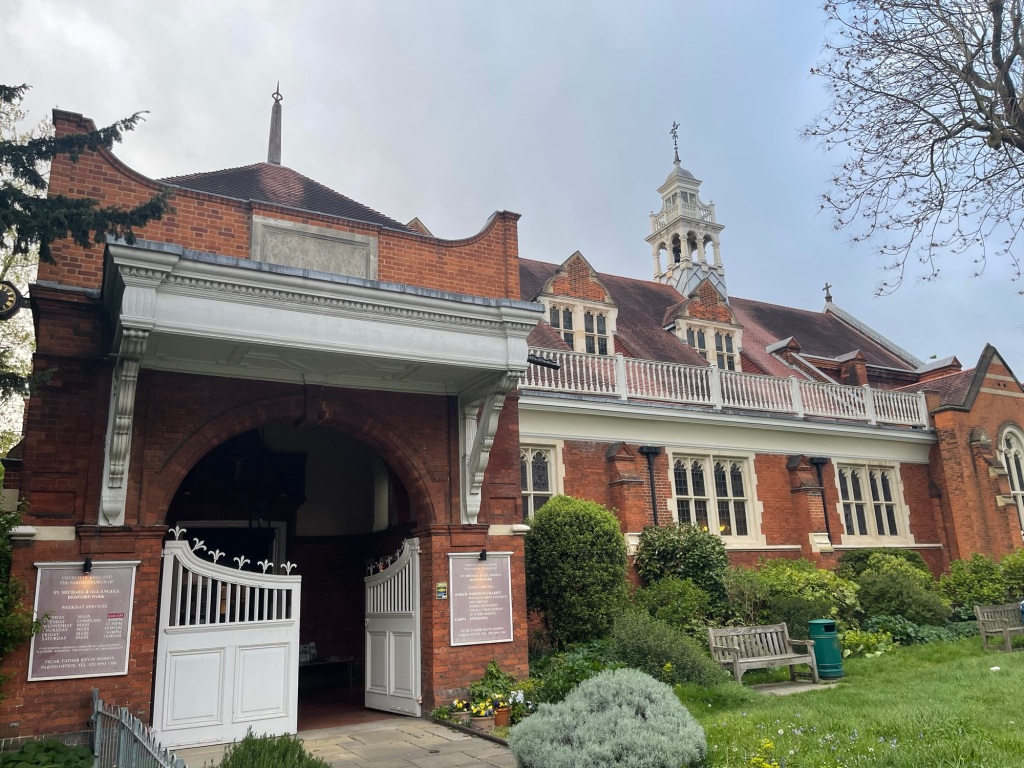
Liszt and Alkan were both fervent believers and it is in their works that this master pianist excels. However his programme tonight opened with two declared atheists with Beethoven’s Moonlight Sonata and Debussy’s Suite Bergamasque.Both were played with impeccable style and intelligence but it was Alkan ‘s ‘Chant d’Amour’ , ‘Le tambour’ and Liszt’s ‘Vallée d’Obermann’ that truly ignited the atmosphere as Mark entered a Romantic world of questioning ,doubt and passionate acceptance.
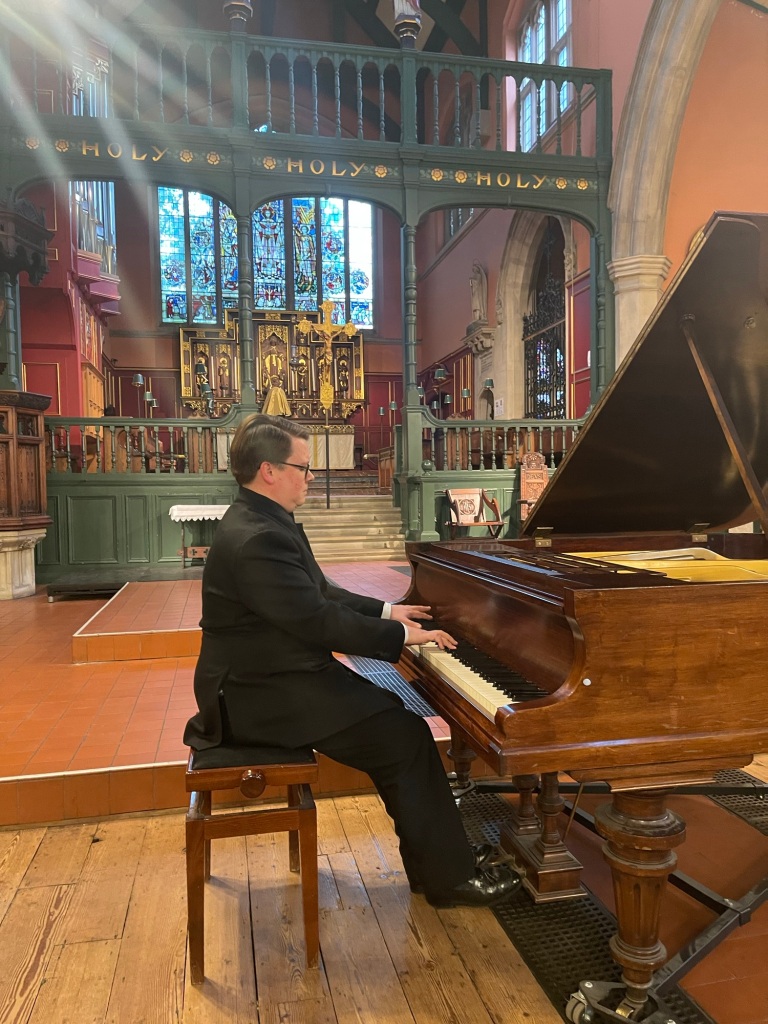
The first work was the so called ‘Moonlight’ Sonata which was a name penned by the publisher to help boost sales.It has become one of the most instantly recognisable of Beethoven’s 32 Sonatas as the first movement is seemingly easier than his others .It became essential fodder for most aspiring amateur pianists back in the days when the aspedestra and upright piano would reign in the front living room where now sits a giant TV screen!
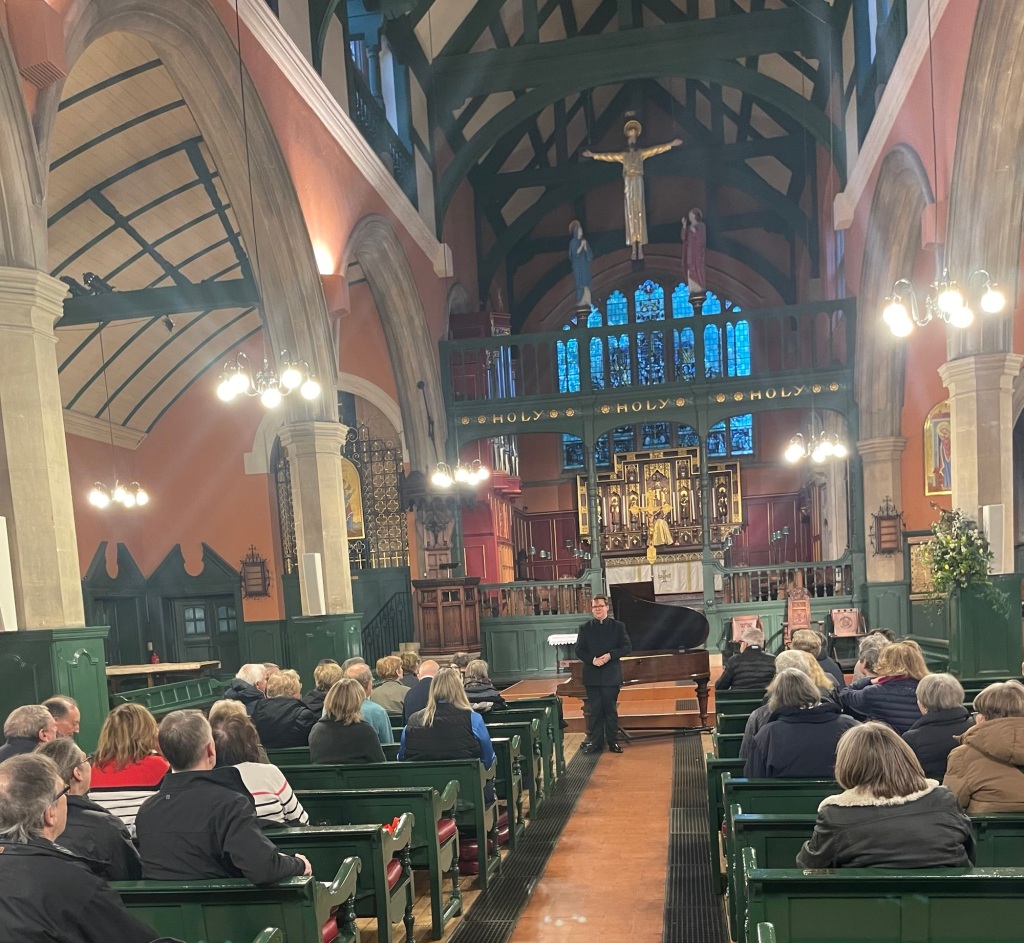
An unusual church beautifully maintained ,with its elegant pastel colours and rich altar dressings,and that is situated at the foot of the first London garden suburb of Bedford Park.I was brought up here and spent the first twenty five years of my life in Flanders road opposite and I remember very well passing everyday the ‘Tabard’ pub and ‘Mulliners’ the car restorer of Bentley cars ,that stood next to it.

I also heard many great pianists play for the Fayrfax concert society that gave concerts in Chiswick Polytechnic. David Carhart would regularly play concertos with the Chiswick Music Centre Orchestra .I remember the one and only time hearing the Rimsky Korsyakov Concerto from his hands and seeing Harry Isaacs,his illustrious much loved Professor from the Royal Academy, disappear into the Tabard afterwards with his students who included the since renowned accompanist and musicologist Graham Johnson.The Fayrfax included pianists such as Peter Katin,Moura Lympany ,Louis Kentner,Iso Elinson ,Joseph Cooper,Gerald Moore and Sidney Harrison himself who presided over this club with his wife Sydney.
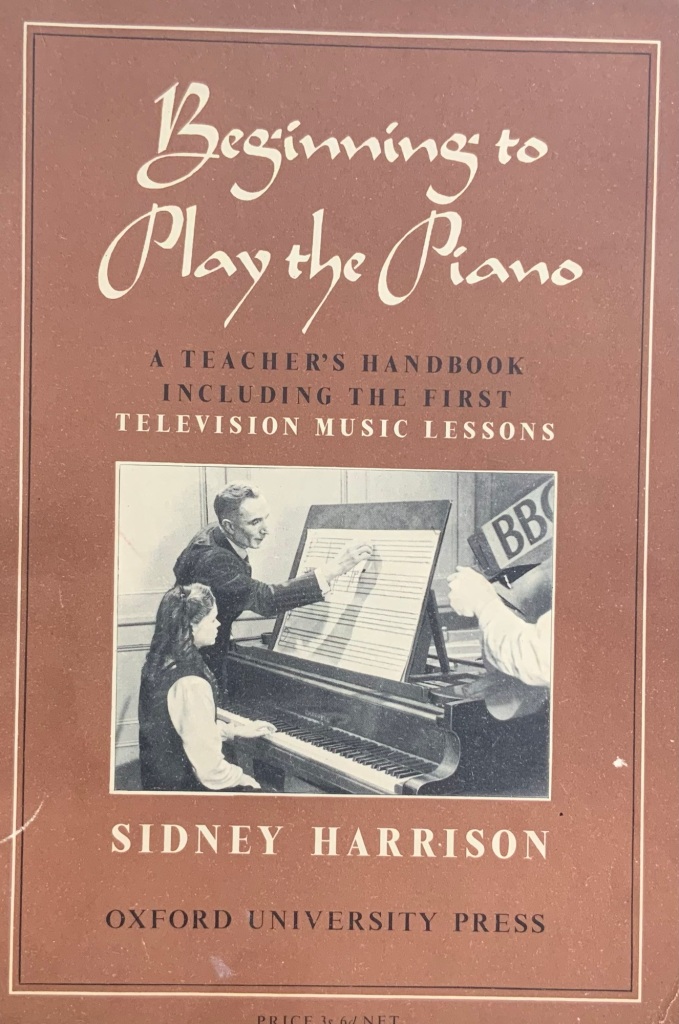
Sidney was eventually to move from Hartington Road (where he lived next to Eamon Andrews of ‘Crackerjack’ and ‘This is your life’ fame) to the Avenue just a stones throw from this magnificent edifice.He was the first person to give piano lessons on television at a time when there was only one channel that broadcast for a few hours each day. Neighbours lucky enough to have a television (that was a large box with a giant magnifying glass ) would invite people in to tune in to see how Peter Croser or Norma Fisher were progressing with their lessons. My mother took me to have lessons with Sidney Harrison who became my mentor and father figure. He took my musical education into hand by taking me to the opera and concerts as well as training me to enter the Royal Academy where I was to continue my studies with him and his great friend and colleague Gordon Green. Eventually proud to see me win the MacFarren Gold Medal,the highest award at the Academy.After my studies in Paris and Rome I came back to reality and began teaching thanks to David Carhart at the Chiswick Music Centre.It had now moved to the top of Belmont School and it fast became part of the West London College of Higher Education by the river in Twickenham.I did though have some private students some of whom were the children of illustrious celebrities living in Bedford Park.Lucy Taylor was my very first pupil and was the daughter of Don Taylor ( who wrote the Exorcist ) and his wife ,Ellen, even more well known as a television playwright .Her best friends were the children of Michael Flanders ,of Flanders and Swan fame.Stephanie and her sister came to me brought by Claudia who was by then the widow of this famous personage .Stephanie was the only pupil whose claim to fame was to fail Grade one piano.Her head was elsewhere ,in economics obviously, as Stephanie Flanders is seen daily on the news talking about the world economic situation.However back to Mark’s wonderful recital .

There was a fluidity that he brought to the opening movement of the Beethoven.It was played in two that allowed the beautifully simple melodic line to float on the wave of the gently flowing accompaniment.A magical sense of balance and architectural shape created exactly the effect that Beethoven would have wanted on pianos of his day that were far less percussive than they later became. Played as Beethoven says ‘senza sordino’ on one string that gives the same etherial effect that Mark created today on an old Bluthner piano ,badly regulated ( as many pianists are wont to bemoan!) but in Mark’s hands became once more an instrument of nobility and pedigree.
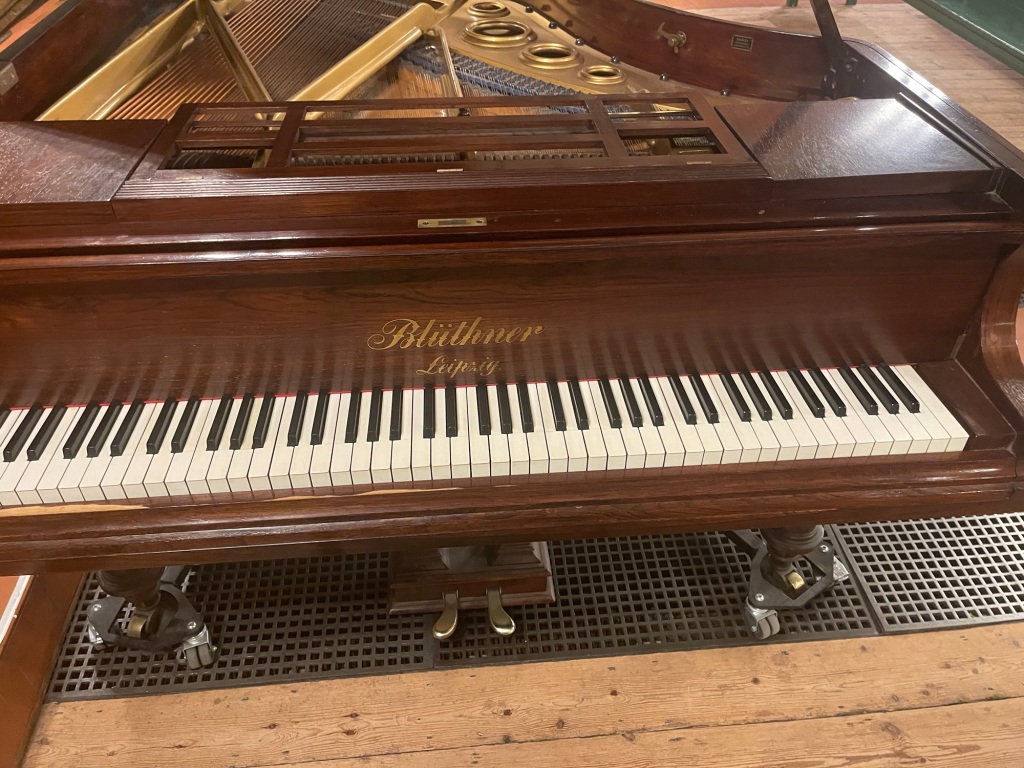
There was a lyricism too to the Allegretto and a beautifully shaped Trio of extraordinary style.The Presto agitato of the last movement (which is where most amateur pianists give up in desperation ) was played with dynamic drive and urgency.There was lyricism too and fantasy as he brought the music vividly and beautifully to life. A sense of colour ,helped by the church acoustic, this noble instrument and of course by the artistry of the pianist.There was a unique effect of having heard this work today with the ink still wet on the page.I have often noted that Mark like his great colleague the Liszt expert Leslie Howard,both sit almost motionless as they listen so intently to the sounds they are creating without any superfluous showmanship.Mark is a dedicated musician and his scrupulous attention to the composers indications was immediately apparent from this very first piece.I have never heard the end of the last cadenza played with the three final notes separated by a portamento and it had me hunting in the score for evidence of something I had overlooked ( and most other pianists too ).It brought a poignant calm to the final two Adagio chords before the nostalgia of the coda that is to erupt in typical Beethovenian irascible style.
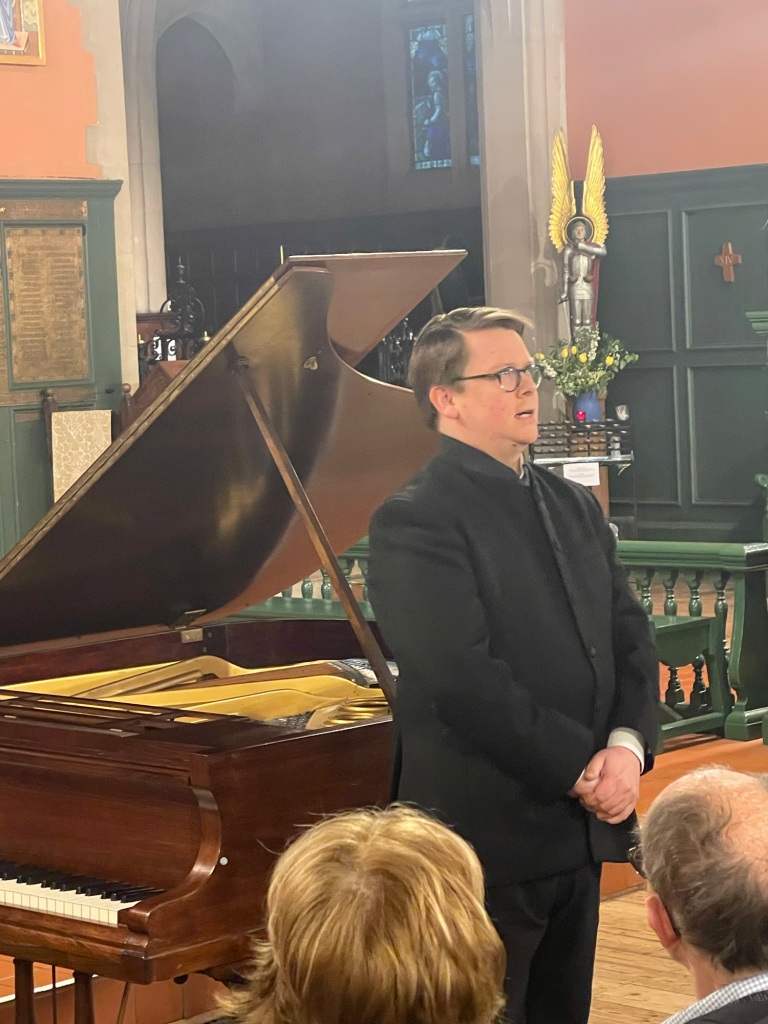
I do not know the two Alkan works that Mark described first in words and then more importantly in music. Mark is an expert on this composer and President of the Alkan Society having won the International Alkan Competition in Greece a few years ago. Now with numerous CD’s of Alkan’s music to his credit I could just sit back and listen to definitive performances of a composer until recently covered in mystery.Enough said that Alkan was part of those genius musicians Chopin and Liszt who were the true innovators of the modern piano technique.Taking the new inventions in the keyboard instruments of their day as a new lease of life for their compositional invention and poetic fantasy. Chopin on his death bed left his unfinished treatise on piano playing to be finished by his esteemed colleague Alkan.
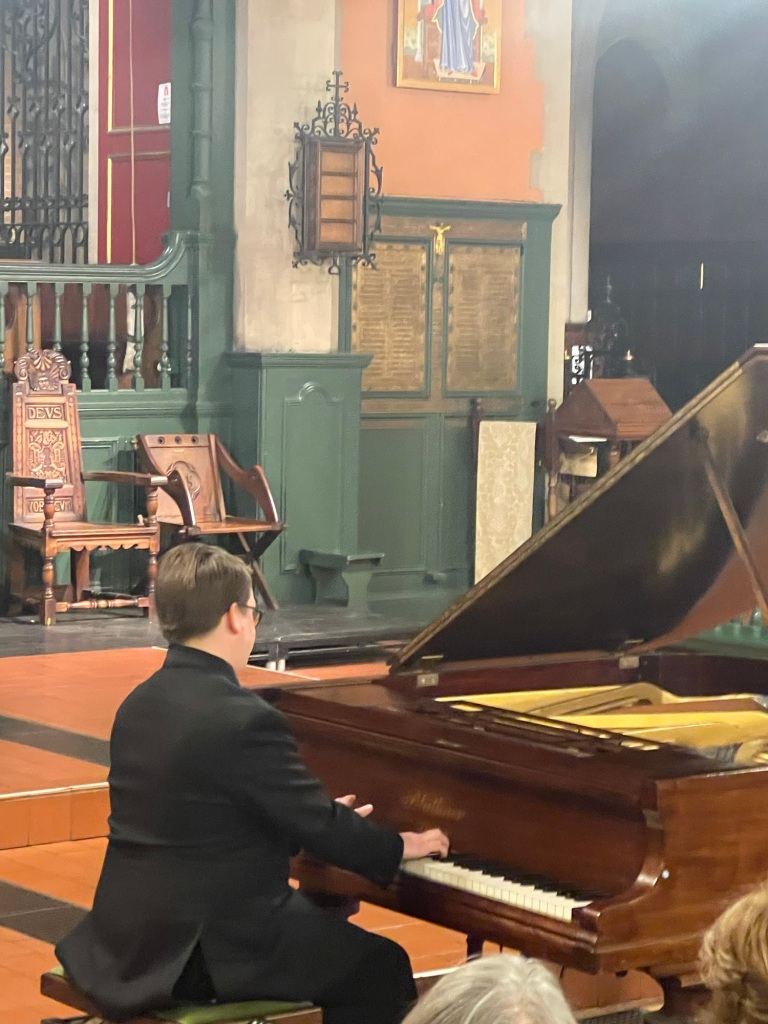
Two short pieces by Alkan were played with fantasy ,colour and extraordinary virtuosity and was enough to make one want to purchase all the many five star CD’s that were on sale at the door! ‘Chant d’Amour’ was a beautiful lesson in Bel Canto and a tone poem of startling originality. A rare sense of colour and sumptuous golden sounds in the climax with a richness of sound from Mark’s masterly hands.There was a burning intensity to the passionate climax before the return of the nocturnal simplicity of the opening. ‘Le tambour’ was even more remarkable for its extraordinary originality.The bass beating of the drum or was it a heartbeat was played with a driving whispered insistence and showed a remarkable sense of control as the melodic line is gradually floated above it. Opening up to passages of startling virtuosity and excitement before returning to the ever present beating with which it had started. Another miniature tone poem played with total conviction and commitment by a master who the world still has to wake up and discover and to appreciate fully. Mark is similar to Graham Johnson who is the expert on Schubert lieder and who is not only a masterly performer but a great writer and researcher of the genius of Schubert and the poets that inspired him.Mark with Alkan has made a study of this unknown composer a life’s mission writing and even more importantly bringing the actual compositions to public notice rather than just reading stale information in history books!
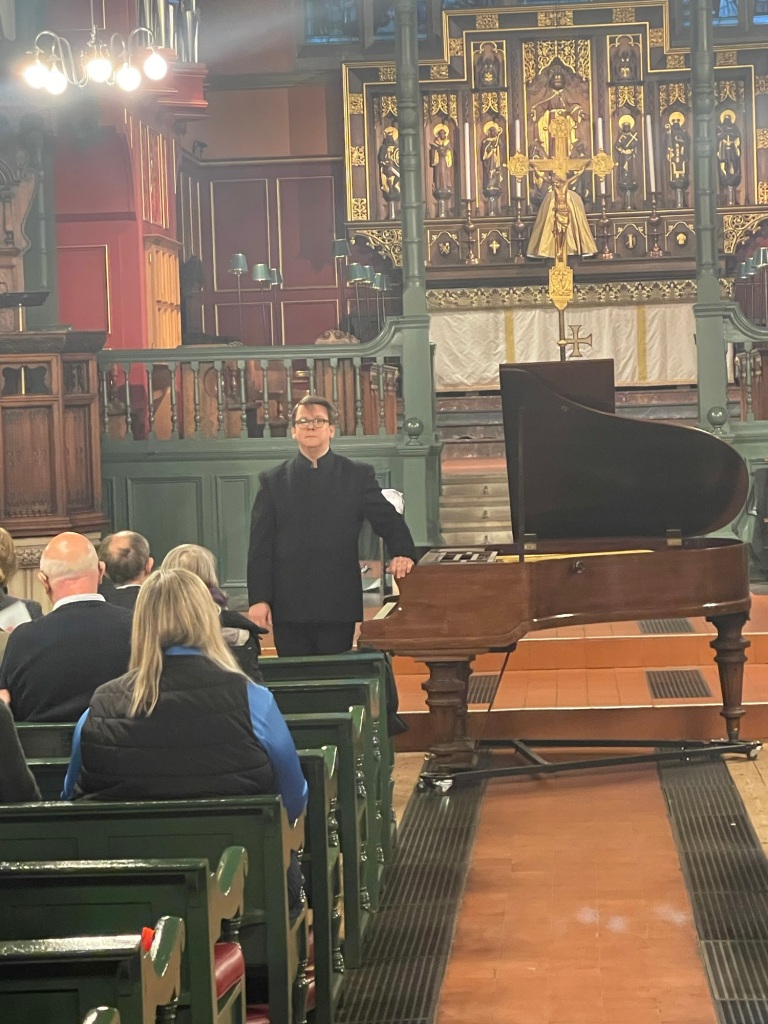
Mark also has time to rethink and bring to life many of the standard works of the piano repertoire where tradition has brought too great a distance between the composers wishes and a rather more personal view of interpreters of the past .It was just such a point with the most famous of all Chopin’s Polonaises – the Polonaise Héroique – and the emblem for Poland’s independence.It was played with great clarity and after the imperious opening the Polonaise theme was allowed to sing with beauty and poignant eloquence as it built up to the climax. Even the infamous left hand octave passages were played like a breeze blowing over the battlefield with the melodic line always to the fore.A wonderful circular movement too in Mark’s left hand was a lesson for all budding virtuosi where Art conceals Art.The beauty he brought to the long melodic episode before the final triumphant climax was helped by the deep bass notes that Mark struck with velvet gloves .It opened up the piano as it allowed an even more sumptuous glow to the meandering beauty of Chopin’s mellifluous outpourings.Where Rubinstein would lift him self up off the seat at the burning intensity of the final bars ,Mark hardly moved but brought the same ( well almost as Rubinstein was quite unique here!) fervent excitement and exhilaration with which he finished the first part of the concert.

Debussy’s unjustly neglected ‘Suite Bergamasque’ as Mark said was a very early work that has very little to do with his later revolutionary compositions where he too brought new possibilities to music for the ever more evolving grand piano .It is interesting to note that he was also editor of all Chopin’s works. Four movements of which the best known and most loved is ‘Clair de lune’ that Mark told us was originally titled ‘Promenade Sentimentale’! All four pieces were played with ravishing colour and delicacy.There was a glowing warmth to the sound in the ‘ Prélude ‘ and a charming grace and infectious lilt to the ‘Menuet’.There was a fluidity and delicacy to ‘Claire de lune’ ,which is another of those pieces that was on the music stand together with Sinding’s ‘Rustle of Spring’. He brought a refreshing simplicity as the music was allowed to unfold with ravishing sounds due to his exquisite sense of balance.There was a continual forward movement to the ‘Passepied’ with its gentle fleeting charm.
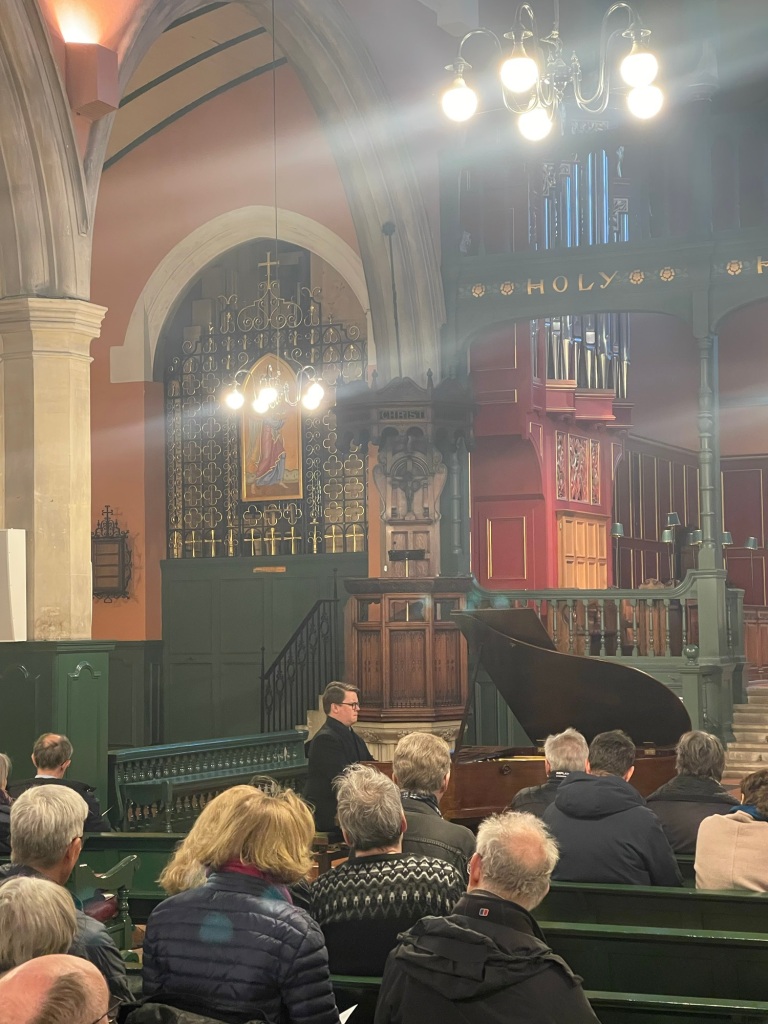
The imaginary landscape of ‘Vallée d’Obermann’ was a magnificent way to finish this recital of ‘Something old and Something new’ a phrase that Semprini would use to open his radio programme!
Obermann, an 1804 novel by the French philosopher, Étienne de Senancour, centers around the mediations of a young, melancholy recluse who retreats into the Swiss Alps to probe profound and unsettling questions. The novel unfolds as a series of letters written by Obermann, the ultimate solitary, Romantic hero. Filled with longing, he is both enthralled and mystified by Nature. He asks:
‘What do I wish? What am I? What shall I ask of nature? I feel; I exist only to waste myself in unconquerable longings…Inexpressible sensibility, the charm and the torment of our futile years; vast consciousness of a nature that is everywhere incomprehensible and overwhelming; universal passion, indifference, the higher wisdom, abandonment to pleasure— I have felt and experienced them all.’
Mark told me afterwards that he had not played this work in public for twenty years and could still put me to shame who has played it for fifty! Thanks Mark for that too!! A wonderful performance of orchestral proportions but also of great poetic license as the searching in music was allowed to unfold with disarming simplicity and a kaleidoscope of colour .One could imagine why Liszt and the Countess D’Agoult would search high and low for it during their visit to Switzerland together in their Years of Pilgrimage.Drama and excitement with recitatives of startling virtuosity until the final murmured return of the opening theme with an ever more ecstatic pulsating of the heart until the final explosion of exhilaration .Cascades of octaves of remarkable difficulty especially if one is to keep the melodic line still intact as Mark did with mastery and intelligence.The final dramatic cadence after a silence of searing intensity was a fitting way to close his recital.

An ovation but no more was expected or offered .Mark is a great artist and knows when to stop!
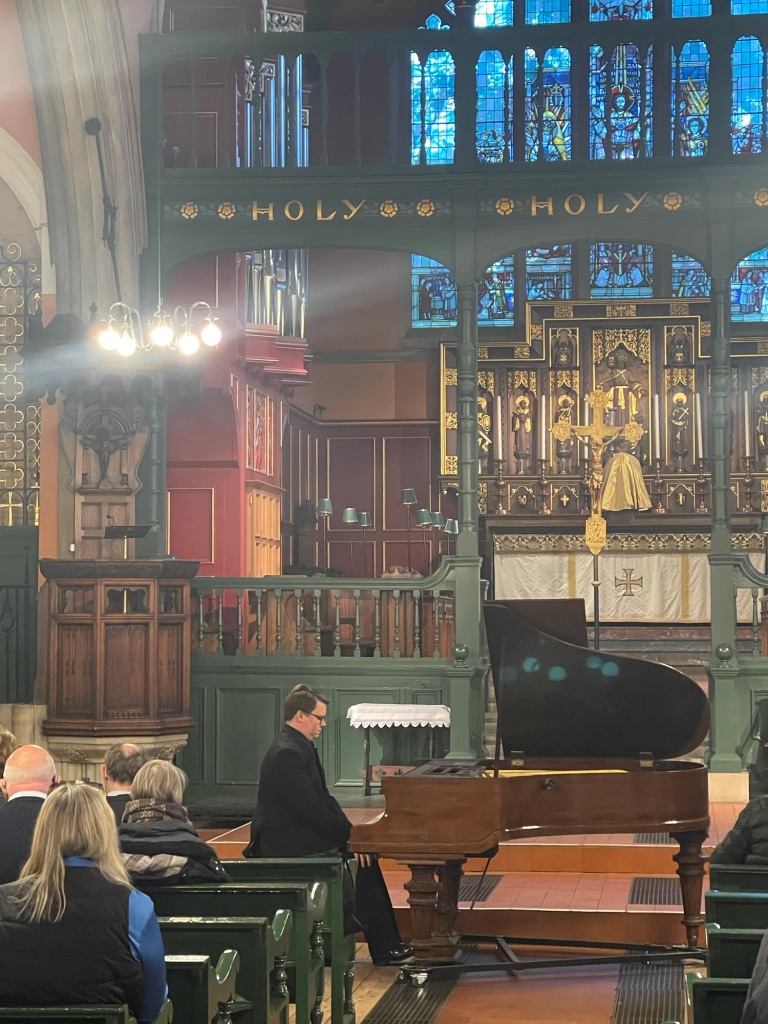
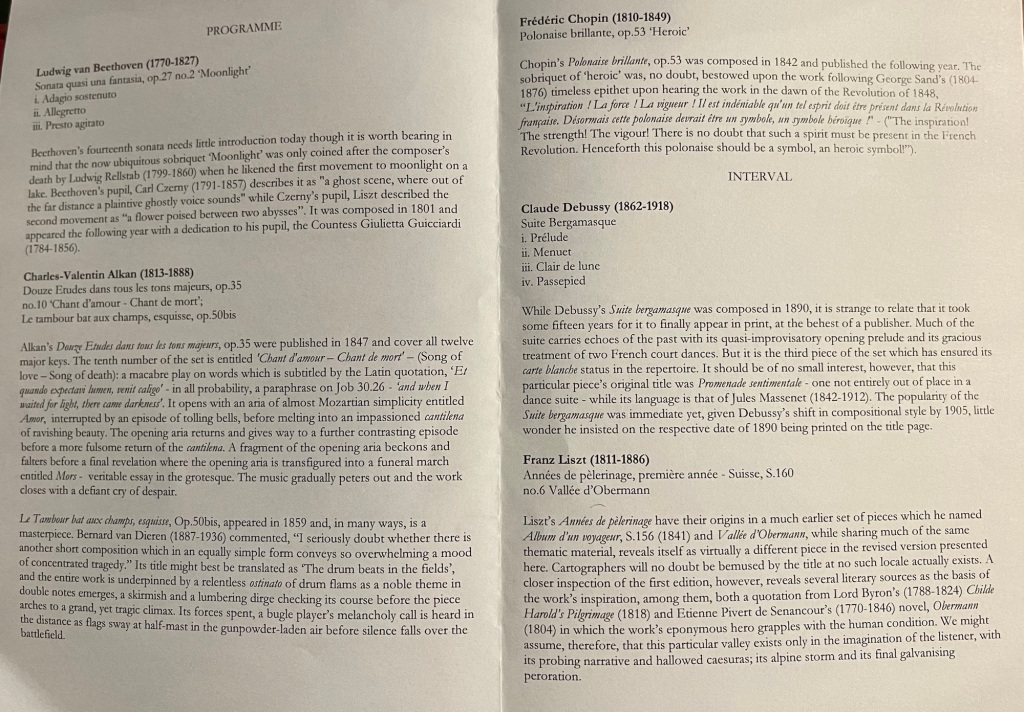
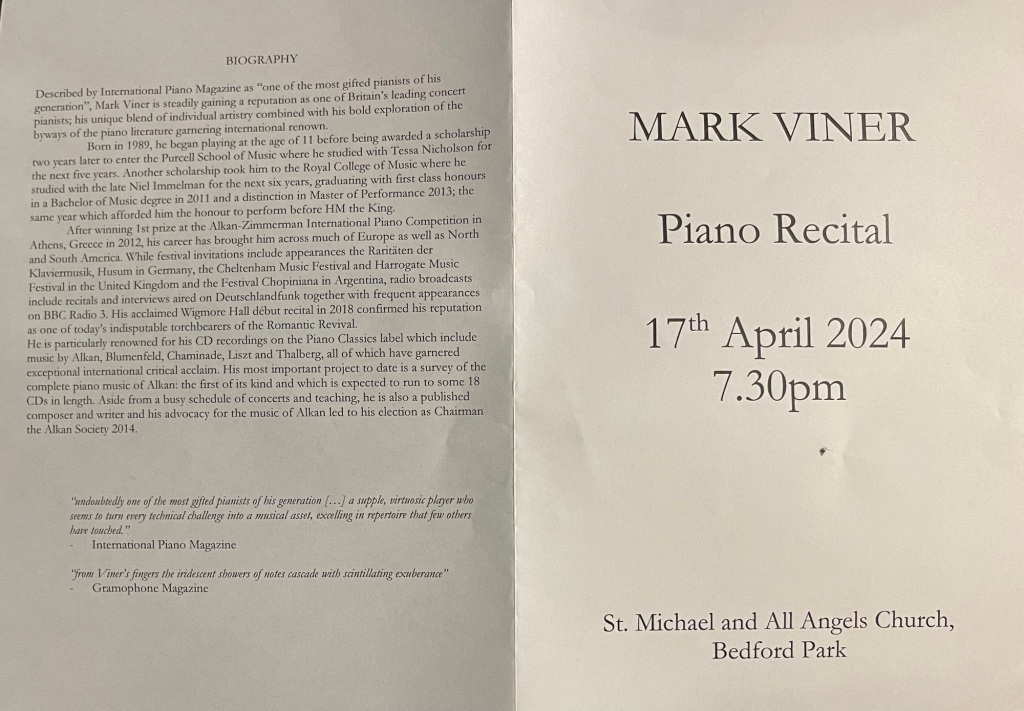

As you may observe I have heard Mark play before ……people might talk says Mark! But the birth of a great artist is a long and difficult road documented in part here in my own poor words .
https://christopheraxworthymusiccommentary.com/2020/03/12/mark-viner-at-st-marys-2/
https://christopheraxworthymusiccommentary.com/2019/03/11/mark-viner-at-st-marys/
https://christopheraxworthymusiccommentary.com/2018/05/05/mark-viner-with-the-camerata/
https://christopheraxworthymusiccommentary.com/2018/03/03/mark-viner-takes-london-by-storm/
https://christopheraxworthymusiccommentary.com/2018/01/18/mark-viner-takes-italy-by-storm/
https://christopheraxworthymusiccommentary.com/2017/02/06/mark-viners-voyage-of-discovery/
https://christopheraxworthymusiccommentary.com/2016/09/22/viners-norma/
https://christopheraxworthymusiccommentary.com/2016/06/04/mark-viner-virtuoso/
Una risposta a "Mark Viner at St Michael and All Angels bringing mastery and discovery to Chiswick"